Stroking is one of the main massage techniques. This technique is usually used to begin and end the procedure. It is also used when replacing one technique with another.
Effect on the body
The effect of this technique on the body is of great importance. With its help, the skin is cleansed of keratinized scales and remnants of the sebaceous glands. As a result of this, the work of skin respiration and the work of the sweat and sebaceous glands are normalized. In the future, we can observe how the skin tone improves, the skin becomes firmer and more elastic.
In addition, blood circulation in the body improves. A beneficial effect also appears on blood vessels, the walls of which become more elastic. If there is swelling, stroking helps eliminate it, because it helps the outflow of lymph and blood.
As a result of this intake, decay products are removed from the body, which helps cleanse the body. Also, with the help of stroking, you can soothe pain from injuries and other diseases.
It also has a huge impact on the nervous system. Depending on the intensity with which the technique is performed, one or another result can be achieved. For example: by performing deeper strokes, the nervous system is excited, while superficial and light strokes bring the nervous system into a state of calm.
It is useful to perform this technique for insomnia, increased excitability of the nervous system, and also after heavy physical activity. With its help, you can achieve complete relaxation of the muscles, which will prepare them for subsequent massage techniques.

Massage appointment
Execution Features
When doing this, your hands should slide easily and freely over the body without moving the skin. This technique should not affect the deeper layers of muscle mass. To make the movements soft and gliding, oil is applied to the body. Using broad movements, the oil is rubbed into the skin, while relaxing and warming the body.
Hands glide easily over the surface of the skin, touching it very gently. All movements are performed along the lymphatic vessels and veins. Exceptions include planar surface stroking, which can be performed regardless of the path.
If there is swelling or stagnation on the body, it is worth starting movements from the overlying area. This will facilitate the outflow of fluid.
As a rule, this technique is used in conjunction with other techniques, but it can be performed as a separate massage effect.
When performing it, it is worth remembering that you first need to use superficial stroking, and only then use deeper techniques.
Deeper stroking should be used on the area of the flexing limbs. It is in this area that the largest lymphatic and blood vessels pass.
The technique is performed rhythmically, approximately 25-26 movements are performed in 1 minute. Movements should not be too sharp or fast to prevent the skin from moving.
Techniques and types of stroking
This technique is divided into:
- planar,
- enveloping.
Planar is usually performed on large and flat surfaces of the body (back, stomach, chest). When performing a flat stroking technique, the hand should be relaxed, the fingers should be straightened and closed. Movements can be arbitrary: in a circle, transverse, longitudinal, in a spiral. It can be performed with one or two hands.
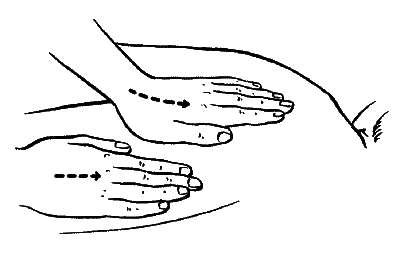
Planar stroking
An enveloping type of stroking is used to massage the arms and legs, to massage the buttocks, neck, and lateral areas of the body. The technique is performed with a relaxed hand, while the thumb should be moved to the side and the rest should be closed. The brush should tightly grip the massaging surface. Movements can be intermittent or continuous.
When performing a technique with both hands, the arms should be parallel and follow a rhythmic direction. If the technique is performed on an area with an excess fat layer, in this case it is necessary to increase the pressure. To do this, you need to put one hand on top of the other, creating additional pressure.

Embracing stroking
Based on the strength of the effect, the technique is divided into:
- superficial,
- deep.
Superficial is characterized by light and gentle movements. This technique has a particular effect on the nervous system, calming it. Muscle relaxation also appears, improving metabolic processes and blood circulation processes.
Deep massage is performed with force. It is better to apply pressure with your wrist. This technique helps eliminate congestion and swelling, and remove stagnation from the tissues. Deeper techniques significantly improve the functioning of the circulatory and lymphatic systems.
The stroking technique, especially planar, can be performed using the back of several phalanges and the lateral surfaces of the fingers. It all depends on what area the massage is performed on. For example, you can use the pads of your index finger and thumb to massage the interosseous muscles.
To massage large surfaces of the body (back, abdomen, chest), you can use stroking with your palm or a hand clenched into a fist.
This technique is also divided into:
- intermittent,
- continuous.
When performing a continuous type of stroking, the palm should fit tightly to the area of the body being massaged. This technique promotes lymph outflow and eliminates swelling. It, in turn, can be alternating. In this case, one hand is raised above the other.
When performing an intermittent type of stroking, the hand movement should be short and rhythmic. This massage technique has an irritating effect on the receptors of the nervous system. Therefore, this type of reception is stimulating.
Depending on the direction of movement, this massage technique is divided into:
- rectilinear,
- zigzag,
- spiral,
- combined,
- circular,
- concentric,
- longitudinally with one or two hands.
A straight-line type of massage is performed with the palm, the fingers of which should be pressed against each other, the thumb slightly moved to the side. The brush should be pressed tightly to the surface being massaged.
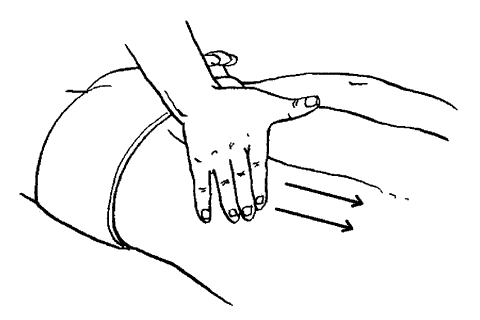
Straightforward
The zigzag look is done in a fast and smooth forward zigzag motion. This technique calms the nervous system and causes a feeling of warmth. It can be performed with different pressure levels.
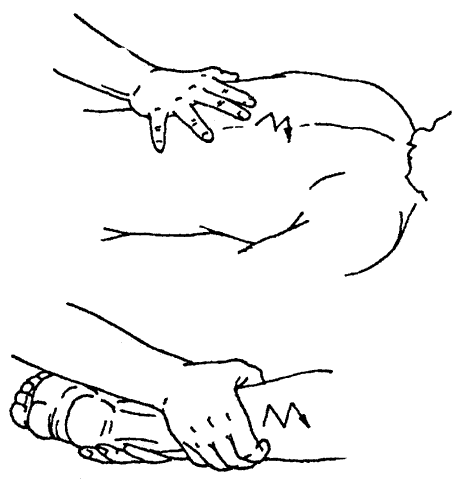
Zigzag
The spiral technique is performed without much tension, the movements are light and sliding. The trajectory of movement should resemble a spiral. This type of intake has a tonic effect.
Spiral
Combined is a combination of straight, zigzag and spiral techniques. It can be performed in different directions.
Combined
A circular type of stroking is performed to massage small joints. As a rule, the technique is performed with the base of the palm, performing circular movements towards the little finger. The movements of the right hand should be directed clockwise, the left - counterclockwise.
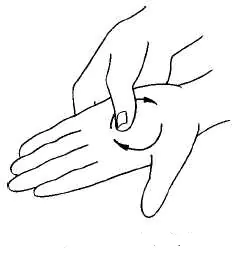
Circular
Concentric massage technique is used to massage larger joints. To do this, your palms need to be placed close to each other. The movement is performed in the form of a figure eight. At first, the force of impact is intense, then the intensity should be reduced.
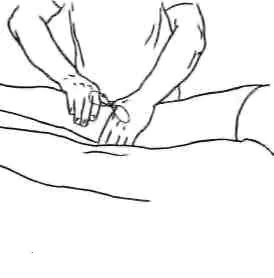
Concentric
To perform a longitudinal type of stroking, you need to move your thumb as far as possible. The movements are performed with the fingertips forward. When performed with two hands, the movements are performed alternately.
Longitudinal
In addition to the basic stroking techniques, auxiliary ones are also used:
- comb-shaped,
- rake-shaped,
- pincer-shaped,
- cruciform,
- ironing
Remembering and applying this technique is not so difficult. You can use all types of stroking at once, or you can choose only those that are most suitable for you.



